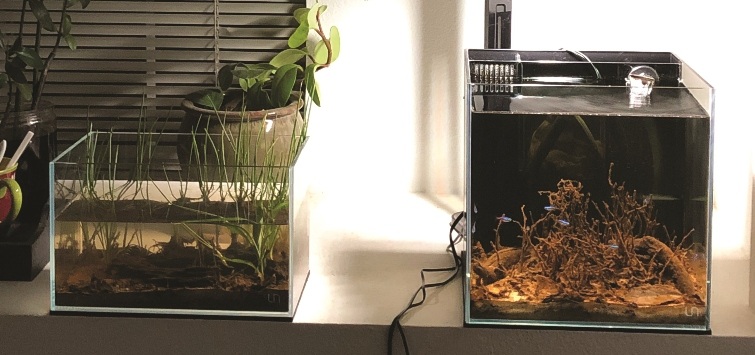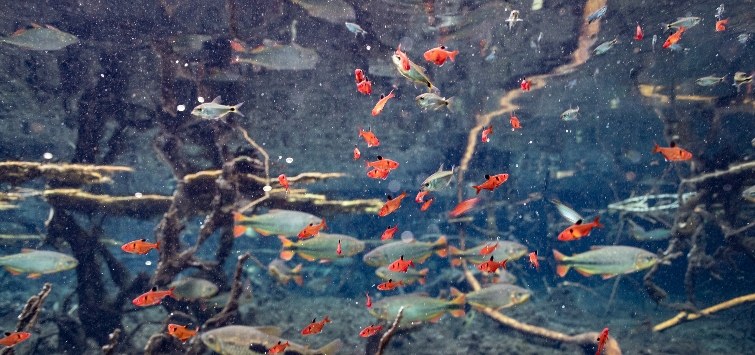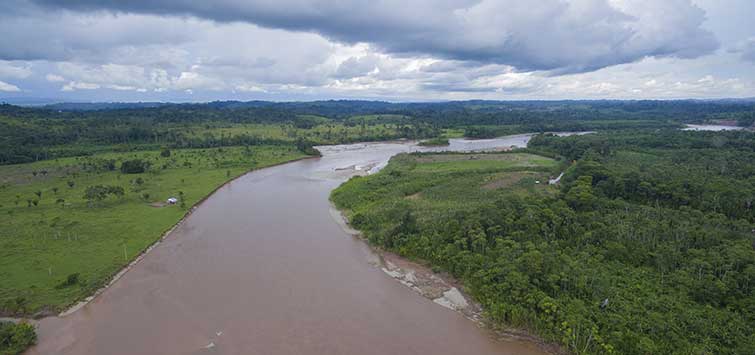Creating a Forest-Flooded Amazon Biotope Aquarium
Land and water are inexorably linked in the fishkeeping hobby, much as they are in nature. Contemplating the dynamic of how water interacts with the environment makes us look at aquatic habitats, and our aquariums, a bit differently. And it all starts with rain.
Weather is one of the most essential and life-giving processes of our planet, and one of its most important components is rain. Life is dependent upon it. Rainfalls are transformational and essential for our continued existence on Earth, just as they are for the fishes we love and the places from which they come.
What interests me about rain is what happens when it occurs in the wild habitats of the species we keep in our aquariums. How do they change with the coming and going of the rainy seasons, and what can it teach us about our own, man-made fish habitats? It is this question that lays the foundation for creating an Amazonian biotope aquarium.
Rainy Seasons in the Amazon
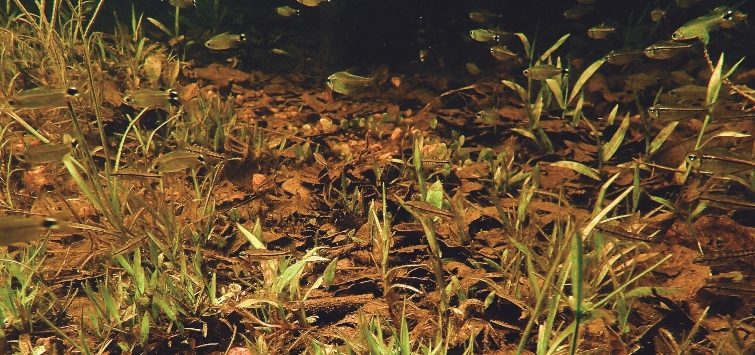
Various fishes forage among the grasses of a flooded forest area in Brazil.
Consider the wet season in the Amazon basin, which runs from November to June. It rains almost every day. But what does the rain actually do? Well, for one thing, rain performs the dual function of diluting organics while transporting more nutrients and materials throughout the ecosystem.What happens in many of the regions of the Amazon is the evolution of our most compelling environmental niches. The water levels in the blackwater rivers and streams rise significantly, often several meters, and the once-dry forest floor fills with water from the torrential rain and overflowing rivers and streams.
This is how the igapós, the local term for blackwater-flooded forest floors, are formed. The formerly terrestrial environment is transformed into an earthy, twisted, incredibly rich aquatic habitat, which fishes have evolved over eons to live in and utilize for food, protection, and spawning areas. The botanical materials—shrubs, grasses, fallen leaves, branches, seed pods, and such—are all suddenly submerged. Often, currents redistribute the leaves and seed pods and branches into little pockets and “stands,” affecting the now-underwater topography of the landscape.
Leaves begin to accumulate. Soils dissolve their chemical constituents, tannins and humic acids, into the water, thus enriching it. Then, in turn, various fungi and microorganisms begin to feed on and break down these materials. Biofilms form, and crustaceans multiply rapidly. Fishes, which race in from the nearby overflowing streams, are able to find new food sources, new hiding places, and new areas to spawn. Life flourishes.
The rains have a huge impact on tropical aquatic ecosystems. And it’s important to think of the relationship between the terrestrial habitat and the aquatic one when visualizing the possibilities of replicating nature in your aquarium in this context.
It’s an intimate, interdependent sort of arrangement. Some parts of these forests may be submerged for almost half a year. A huge proportion of the Amazon river system’s water is in these igapós. They are precious, diverse natural treasures, and replicating one in the home aquarium is a wonderful way to learn more about them.
The Igapó Aquarium
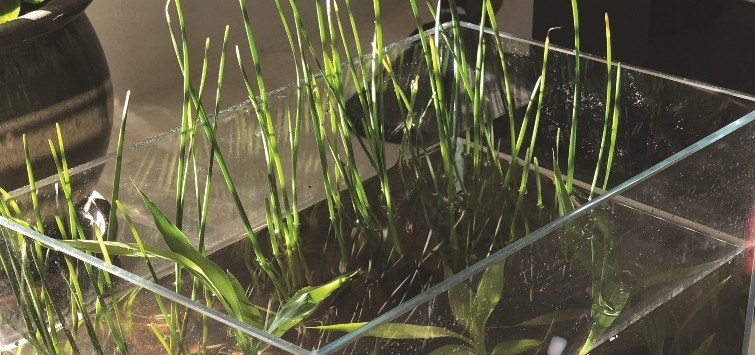
One of the author’s Igapó biotope setups in its inundation phase hosts a variety of life forms, including aquatic crustaceans, plants, and of course, fish.
For years, I thought about how interesting it would be to create an aquarium around the seasonal changes that occur in such a habitat. That was the basis of what I have taken to calling my “Urban Igapó” concept: starting out with a dry “terrestrial” habitat and gradually flooding it to simulate the rainy-season inundations that these habitats go through annually. I’ve done this whole cycle now many times in a wide variety of aquariums, experimenting with various aspects like soil composition, planting, fish stocking, and other variables along the way.It’s become one of my favorite projects, and I hope to inspire more aquarists to play with the idea themselves. By attempting to replicate this seasonal cycle of inundation, we can gain new insights into these dynamic natural habits, and a new understanding of how our fishes are tied to them. It’s different, and challenging. And it’s fascinating.
The idea of “flooding” a fish tank set up as an Amazonian forest-floor biotope aquarium and replicating some of the processes that happen seasonally in nature, creating a true year-round habitat simulation in the confines of an aquarium or vivarium, has never been more attainable.
I suppose that, on the surface, it’s hardly an earth-shattering approach: You set up an aquarium, but you don’t fill it with water right away. You instead add a mixture of soil and conventional aquarium sands, grow some terrestrial plants and grasses, and allow them to take hold. Then, you bring on the “rainy season” by flooding it and adding fish. After a few months you begin drawing down the water significantly, ultimately returning it to its “dry season” state. Then repeat the whole cycle, as many times and at whatever frequency you desire.
It’s not really difficult. This process mimics the dry-start method that many aquatic plant enthusiasts utilize. Except the goal isn’t to start plants for a traditional aquarium; it’s to replicate, on some levels, the year-round dry season/wet season dynamic of the Amazonian forests.
Plant Selection
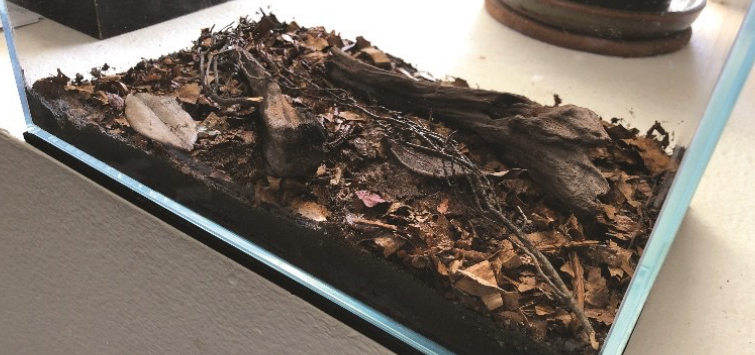
By utilizing leaves, seed pods, and other botanical materials, a faithful representation of the forest floor can be a created as a substrate.
While some of you may be familiar with the dry-start method for planted tanks that has been around for years, we’re taking a slightly different approach here. I favor immersion-tolerant terrestrial plants and grasses grown from seed to start the cycle. You can also utilize some emergent-tolerant aquatic plants in your igapó setup; I’ve done this a few times with great success. The added benefit is that they typically look as good in the terrestrial phase as they do in the aquatic phase.
Of course, you could also use riparian-type plants, like sedges, sweet flag (Acorus), and such, which can tolerate or even require immersion and very moist soils for long-term health and growth. Some species of these plants are indeed found in such environments in nature, so it goes without saying that you should experiment with them in the aquarium, too.
You’d need to gradually flood the “rainforest floor” of your Amazon biotope aquarium, which could be accomplished manually by simply pouring water into the tank over a series of days, or automatically, with solenoids controlling valves from a reservoir beneath the setup, or perhaps even employing the misting systems that frog hobbyists use, if you’re into technical solutions.
This is all very achievable, even for hobbyists like me with limited DIY skills. You just have to innovate and be willing to do a little extra work. You can keep it incredibly simple and just utilize a small tank. But you must be patient.
More than an enjoyable “hobby within a hobby,” an igapó biotope aquarium is also a dynamic system that we can and should learn more about as aquarists. When we flood an aquarium and then allow it to dry, attempting to replicate this wet-and-dry-season cycle, we have to figure out how to manage a number of different dynamics, ranging from varying levels of nutrients to nitrogen cycles to fish stocking.
The seasonal dynamic is broad-reaching and multifaceted in the aquarium, as it is in nature. And not just for its unique aesthetics, either. As the display is flooded, the materials in the formerly terrestrial environment become submerged as they do in nature, releasing nutrients, humic substances, and tannins, and thus creating a rich, dynamic habitat for fishes.
Again, we have the opportunity to recreate aspects of this process in both form and function. Replicating this seasonal change is not complicated or difficult. It only requires some active management, planning, and diligence. On the surface, though, executing it is no more challenging than some of the other aquatic systems we hobbyists set up and maintain.
Flooding the Igapó Biotope
You’ll have to make some provisions for relocating any frogs or other terrestrial-dwelling inhabitants of your system to “higher ground” (i.e., a vivarium) during the “wet season,” or you could create a paludarium-type setup, with both a terrestrial and an aquatic component simultaneously.As mentioned previously, you’ll have to deal with some aesthetic challenges as you flood the system. The turbidity, biofilms, decomposition, deeply tannin-stained water—stuff that we as botanical-style aquarium enthusiasts are already pretty well trained to accept and embrace.
One could even represent various phases of the inundation, as I have done in some of my aquariums. It’s not everyone’s cup of tea, but it is remarkably similar to what you see in nature during the latter part of the inundation cycle, where terrestrial vegetation is largely dormant, and only lingering turbidity and a smattering of living vegetation remains.
The possibilities for education, creative expression, and experimentation are wide open here.
Questions and Answers
This rather unorthodox wet season/dry season approach to keeping a biotope aquarium might leave some with questions, so I will try to address them one by one.
What size aquarium do you need?
You can use just about any size aquarium. Most of my executions have been in smaller tanks, but of course, you can scale this up to medium and large aquariums. The concept and the implementation are the same.
The biggest challenge, in my opinion, is embracing the fact that you might set up a large tank that may not have any fishes in it for months. You just need a little patience.
Do the grass and plants that you’ve grown in the “dry season” survive the inundation?
Well, some do, and some don’t. I’ve used grasses in my setups that are immersion tolerant, such as Paspalum. This stuff will hang around for a while submerged, for about a month and a half to two months in my experience, before ultimately succumbing. Sometimes it comes back when the “dry season” returns. However, when it doesn’t survive, it decomposes in the now aquatic substrate and adds to the biological diversity by cultivating fungi and bacteria.
You can use many plants that are riparian in nature or capable of growing emersed, such as my favorite, Acorus, as well as plants like pennywort (Hydrocotyle) and swordplants (Echinodorus). You can even use plants from outside the Amazon, such as Cryptocoryne. These can, of course, survive the transition between the aquatic and terrestrial environments.
What kinds of fish can you keep in these systems?
I’ve kept several different types of fishes in these setups, particularly annual killifishes and small characins. For biotopes outside the Amazon, gouramis and bettas work well, as do the annual killies from Africa. There are a lot of possibilities, as you’re certainly not limited to the igapó (blackwater flooded forests) and varzea (whitewater flooded forests) of South America. There are numerous similar habitats around the world that you could replicate on some level.
You could mimic all sorts of geographic locales and niche habitats, including those found in Africa and Southeast Asia, such as temporal pools and seasonal streams. Annual killifish would be another beneficiary of such a system, with the ability to literally desiccate their environment for the dry season and flood it once again to simulate the return of the rains.
We kind of do that already with the old “peat moss in a bag” trick to incubate killie eggs. This is just a more interesting (and, granted, somewhat more complicated) way to do it, but it’s also one that may yield interesting insights into the natural habitats and behaviors of annual fishes.
Do I have to have a “dry season?”
The whole idea of this particular approach is to replicate as faithfully as possible the seasonal wet and dry cycles that occur in these habitats. It starts with a dry or terrestrial environment, managed as such for an extended period of time, which is gradually flooded to simulate the inundation that occurs when the rainy season commences and swollen rivers and streams overflow into the forest or grassland.
How long should the “dry season” last?
If you want to mimic one of these habitats in the most realistic manner possible, follow the exact wet and dry seasons as you’d encounter in the locale you’re inspired by. Alternatively, if you’d like to extend the wet season to give your fish more time in the tank, I’d at least go two months dry to encourage a nice growth of grasses and plants prior to each inundation.
How much of a mess does it make when you flood the tank? Does the water quality decline rapidly?
When you add water to what is essentially a terrestrial planter box, you’re going to get cloudiness from the sediments and other materials present in the substrate. You will also likely have clumps of grasses or other botanical materials floating around for a while.
But, surprisingly, in my experience the water quality stays remarkably good for aquatic life. I’m not saying that it’s all pristine and crystal clear; however, if you let things settle a bit before adding fishes, the water clears up and a surprising amount of life emerges, including various infusoria.
Curiously, I personally have not recorded ammonia or nitrite spikes following the inundation. That being said, you can and should test your water before adding fish. You can also dose bacterial inoculations into the water to help.
Should I use a filter in the “wet season?”
You certainly can. I’ve gone both ways, using a small internal filter or sponge filter in some instances. I’ve also gone with a simple airstone. But most of the time, I don’t use any filtration. I just conduct partial water exchanges like I would with any other tank, although I take care not to disturb the substrate too much if I can help it. When I scale up my igapó experiments to larger tanks, I will generally incorporate a filter.
It’s All About Experimentation
All sorts of fun variations are possible with a flooded-forest tank. Remember, it’s about experimentation: studying, observing, and replicating a natural process in the aquarium to the best of our capabilities. Artistic liberties are not only allowable, they’re largely the whole point of this type of project.
The ongoing experimentation, the mental shifts it causes you to make, combined with the established “norms” of botanical-style aquarium keeping—all of these aspects come together to make the igapó Amazon biotope aquarium a unique, enjoyable, and educational experience for fishkeepers with enough sense of adventure and curiosity to try it for themselves.
See the full article on TFH Digital
https://www.tfhdigital.com/tfh/sep_oct_2021/MobilePagedReplica.action?pm=2&folio=66#pg69

.png?h=595&iar=0&w=2781&hash=5FD5E69473BCC22199FBFA2FB71B6033)
